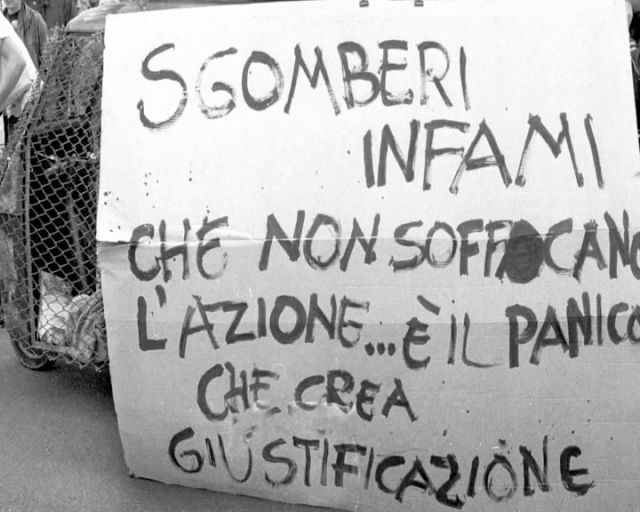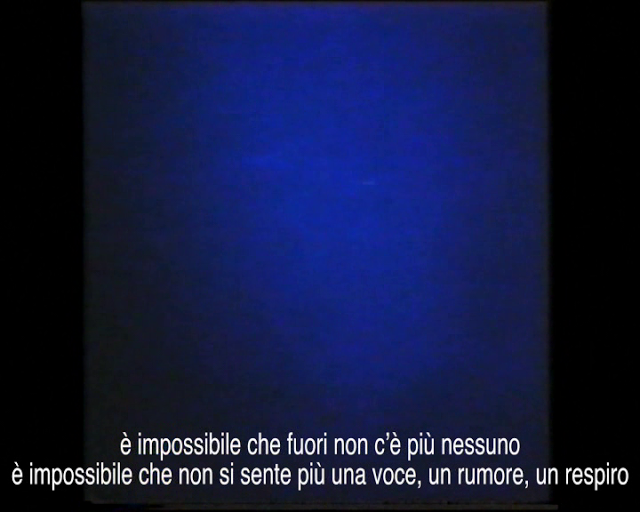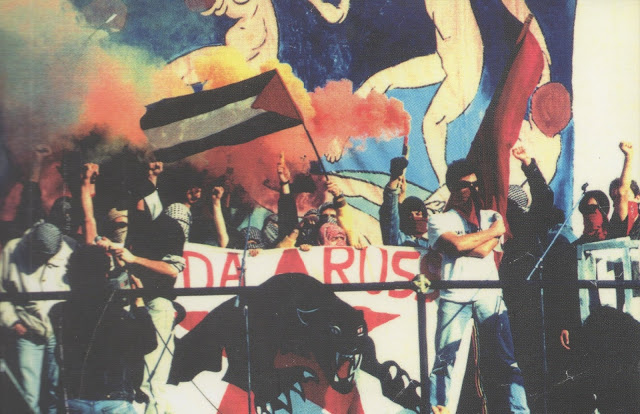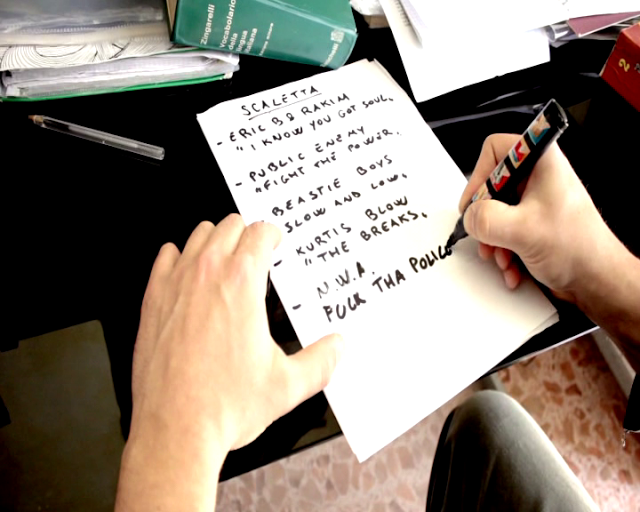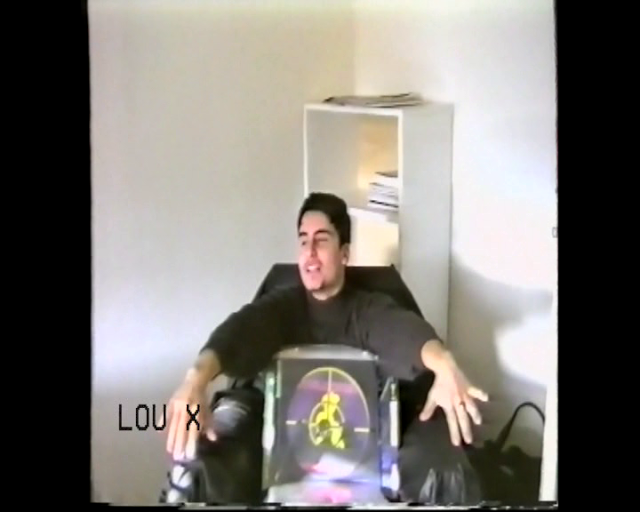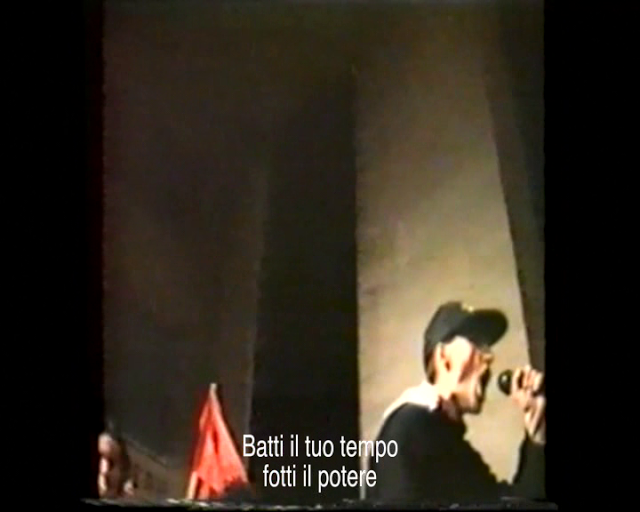[screenshots reproduced with permission]
Sul finire dello scorso Novembre, All’Assalto – Le radici del Rap in Italiano è stato lanciato in pre-order tramite la pagina FB All’assalto. Trattasi di Libro + DVD, per la regia di Paolo Fazzini (aka FAZ di Menti Criminali), il cui obiettivo, citando l’introduzione di Joseph Sciorra (aka Papa Joe), è quello di ‘indagare le radici del rap in lingua italiana sviluppatosi ad opera di quelle crew che hanno rappresentato il controverso fenomeno delle posse.’
Proseguendo la citazione, ‘il racconto di All’Assalto va dal 1989 al 1994 e non vuole essere una storia del rap italiano, ma una fotografia di quei primissimi anni ’90, un momento nel quale è germogliata [una delle] novità più significative nel panorama musicale italiano dalla fine degli anni ’80 ad oggi’. Lo sforzo dell’affermato autore televisivo, regista e documentarista Paolo Fazzini per l’Associazione Nazionale Filmaker (qui è possibile leggere un’interessante intervista legata ad un particolare aspetto della sua attività), giunge in un periodo di forte rivalutazione del genere hip-hop in Italiano, sia in termini di giudizio di critica che di attenzione mediatica. Si veda, a titolo di esempio, Numero Zero di Enrico Bisi. Il documentario utilizza come soundtrack diverse tracce chiave che forniscono una efficace presentazione del periodo in questione, accompagnate da una colonna sonora originale composta da David Nerattini, ascoltabile qui. Per alcune clip extra: qui.
Il regista Paolo Fazzini ha cortesemente deciso di contribuire al nostro articolo preparando una lista di releases essenziali per comprendere il periodo di fermento musicale, politico e sociale sotto indagine. Per l’elenco completo in forma scritta rimandiamo alla conclusione dell’articolo, in coda alla versione Inglese. Nel frattempo, ecco la playlist YouTube corrispondente:
All’Assalto è un breve e ben contestualizzato resoconto di un periodo storico fertile e contraddittorio allo stesso tempo, indissolubilmente legato a quello spartiacque della storia politica e sociale dell’Italia che rappresentò la fine catastrofica della Prima Repubblica, e dall’inizio altrettanto tragico della Seconda. Periodo che, ad un’indagine a posteriori, ha contenuto allo stesso tempo sia gli ultimi bagliori di speranza e fiducia nella lotta politica antagonista organizzata ed efficace, sia i primi segnali di disfatta programmatica, determinata dalla diffusione permeante della tecnologia mass-mediatica e dal fallimento della Lotta in quanto incorporata e mai più (non ancora, almeno) rielaboratasi in forme originali. Il documentario si sviluppa come racconto in prima persona, ed attraverso interviste esclusive, documenti video straordinari e la partecipazione dei veri protagonisti ripercorre cronologicamente le vicende di maggior impatto per la comprensione del movimento musicale-politico di fine anni ’80. All’Assalto coinvolge, tra gli altri, Assalti Frontali (Militant A e Castro X), 99 Posse, Papa Ricky, Sud Sound System, AK47, Il Generale, Mc Shark, Sa Razza Posse, Leleprox, Dj Disastro, DJ R, A.N.D., C.U.B.A. Cabbal, Treble, DJ R, O’Zulu, e molti altri ancora. Particolare menzione va fatta alle apparizioni illuminanti di Alberto Piccinini, giornalista del Manifesto e figura chiave per la diffusione del movimento. Nei contributi extra del DVD troviamo un intervista ad Amir, più Menti Criminali, Lou X & Dj Disatro in Concerto, 1992, mentre il libro che accompagna l’edizione raccoglie, oltre alla sopracitata introduzione ed alcune parole del regista, una serie di testimonianze fotografiche interessanti e suggestive (articoli di giornale, flyer, artwork di demotape o LP, foto di artisti, live o manifestazioni.
[Screenshot]
La vicenda di cui Paolo Fazzini tratta ha origine a partire dalla seconda metà degli anni ’80, ovvero l’ultimo periodo di agitazione politica in qualche modo accostabile al vivace attivismo di fine anni ’70, al quale corrispose l’esplosione sociale e musicale della cultura hardcore punk e, più indirettamente, le sperimentazioni industriali/rumorose italiane. Le agitazioni porteranno, tra gli altri fenomeni, a grandi movimenti studenteschi e dell’Autonomia Operaia, aventi come centri nevralgici Roma (Movimento della Pantera, Occupazione dell’Università del Gennaio 1990) e Bologna. La narrazione ad ogni modo non si limita a riportare gli sviluppi musicali più interessanti relativi a quelle due grandi città, ma al contrario viene estesa fino alle regioni più periferiche e dimenticate della penisola. La provincia di piombo: ‘se ripenso a quegli anni, mi chiedo: cosa altro potevamo fare [] se non girare sgangherati corti in periferia e scrivere testi rap? Tu non hai idea di cosa sia stata la provincia in quegli anni. Essere due adolescenti in una cittadina in cui l’unico passatempo era lo stadio, e se non era lo stadio era l’eroina. Le domeniche pomeriggio in cui non c’era niente, a parte l’angoscia più totale’ (via). L’attività dei movimenti sorti in zone periferiche come Ascoli Piceno, il Salento, Sassari e molte altre, si pone in continuità con il fervore giovanile musicale alternativo dell’hardcore punk, nel contesto del quale voci isolate da tutta la provincia italiana si affiancavano alle grida provenienti dalle grandi città industrializzate in pieno degrado. Episodi del documentario emblematici in tal senso sono: il discorso fatto da Il Generale, il quale illustra come, nella comunità rap nascente, il dibattito riguardo al cantare o meno in italiano fosse già stato assorbito grazie alla lezione hc anni ’80; i ringraziamenti ai Negazione nel singolo di Papa Ricky; la struggente traccia 0516490872 degli AK 47, dedicata a Silvia Baraldini, con sorprendenti punti di contatto con il testo di Troppo Lontano dei Kina (ci deve essere qualcuno lì fuori / non è possibile tutto questo silenzio / non c’è più nessuno che scriva o che dica qualcosa / ma qualcuno deve essere rimasto vivo). Allo stesso modo, l’hip hop italiano riprende certi aspetti lirici della musica alternativa del periodo, rappresentata da Litfiba e CCCP, i quali esercitarono enorme influenza anche a livello performativo (si veda l’esibizione degli Onda Rossa Posse accompagnata da due ballerini neri scatenati: Batti il Tuo Tempo).
[Screenshot, AK 47 – 0516490872]
All’Assalto testimonia un punto di incontro entusiasmante di diverse culture, quali quella politica antagonista italiana, l’hip hop nero made in USA e la cultura dancehall reggae (il tutto proveniente l’lnghilterra, crocevia europeo di diffusione di tendenze d’oltreoceano). Questo incontro portò alla nascita di qualcosa di nuovo, eppure proriamente Italiano. A riprova di come lo scambio culturale e umano sia una ricchezza più che una minaccia – assurdo come, in effetti, si debbano validare nuovamente certezze di questo tipo, ancora oggi. Il rap in italiano, grazie alla possibilità di adattamento ritmico e metrico al tempo 4/4, ha costituito una forma di espressione di pensiero politico (nelle modalità iniziali del genere) duttile e facilmente adattabile ai più disparati dialetti locali, portando concretamente alla definizione di un nuovo linguaggio folkloristico-popolare che comunica in versi e non più in slogan. Dalla rielaborazione di stilemi della musica afroamericana (‘L’electro allora era visto più come una propaggine della musica da discoteca’, e ‘Qualcuno cominciava a parlare di ‘morte del rock”), fino all’aggiornamento / evoluzione della forma di comunicazione politica maggiormente utilizzata.
Non è un caso, infatti, che il movimento hip-hop italiano fosse in forte contrasto con la linea di pensiero sinistroide-istituzionalizzata del PCI dei vari Garrone, Napolitano e Cossutta (Rosso fuori, bianco dentro). In un contesto del tutto diverso, volendo più estremo e distaccato (leggasi, disperato), qualcuno reagiva all’Ortodossia ridicolizzando le contraddizioni della società del momento, fondata sull’incorporazione di prassi nazifasciste, operando una sintesi spiazzante di iconoclastia e violenza. In quello delle Posse, invece, si reagì cercando nuovi modi per comunicare al Compagno in modo efficace, e perchè no divertente: ‘la Rivoluzione deve sorridere’. Mai spensierato, ad ogni modo.
Il documentario tratta marginalmente anche alcune tematiche note alla cultura musicale ‘indie’ (qualcunque possa essere il significato di questo termine), quali, ad esempio, la diattriba ‘pro’-major, per aumentare la potenziale diffusione del messaggio, o anti-major, per mantenere inalterato il controllo sulla propria espressione sincera. La questione già nel 1994 cominciava ad avere un certo peso, si veda ad esempio il contratto di distribuzione firmato dalla Century Vox con Sony, o allo sdoganamento della forma del rap attraverso Jovanotti e La Repubblica.
[Foto per gentile concessione di Luca Mascini – MilitantA. Appare in prima di copertina di Storie di Assalti Frontali – Conflitti che producono banditi, DeriveApprodi collana Fuorifuoco, 2015 (4°edizione)]
Per questa serie di argomenti discussi, All’Assalto può considerarsi a ragion veduta uno dei migliori ed interessanti documentari di settore, grazie alla capacità dell’autore di mantenere alta l’attenzione dello spettatore, ed inanellare le testimonianze intrecciando e sviluppando il discorso. Esso offre diversi spunti dal forte impatto emotivo, tra i quali spiccano: un filmato dell’Onda Rossa Posse che esegue Batti il tuo Tempo di fronte a Matisse ed una folla dai volti coperti e fumogeni accesi; un devastante footage di Gocce di Sole degli Assalti Frontali, dedicata all’amica Paola scomparsa prematuramente, in cui crew e pubblico si fondono in uno straniato grido (‘Una di Noi, Una di Noi, Una di Noi’).
All’Assalto è un documento da non lasciarsi sfuggire. Un punto di partenza per un analisi sul presente più che un gingillo per nostalgici. Ed è anche al pubblico giovane che Paolo Fazzini si vuole indirizzare. Più che mai attuale è infatti la questione legata all’effettiva possibilità di costruzione di un linguaggio antagonista / politico, che possa rinvigorire la fiducia nell’avere effettivamente un peso nella determinazione del proprio destino. Ammesso che, ad ogni modo, possa effettivamente esistere una forma di espressione alternativa (/ sincera) che non venga immediatamente assorbita, rielaborata ed impacchettata dall’ipercinesi della società attuale. O che, in modo ancor più nefasto, sia mai realmente esistita una possibilità di negazione del e sopravvivenza al Potere. All’Assalto: una visione consigliatissima, il cui forte messaggio (di speranza, addirittura?), va meticolosamente ascoltato. Dall’introduzione fino al finale tragico, catastrofico. Vedere per credere.
‘Spalle al muro e davanti il presente /spacciato come l’unico futuro / vedi io so che quello che abbiamo / è solo quello che noi ci siamo presi / e tu sei così speciale che vederti lasciarti andare / è un delitto tale [..] / non vorrò niente in cambio / se non vederti splendere’
[Assalti Frontali [Militant A // Bonnot] ancora in azione, dal nostro canale Paynomindtous LIVE]
ENGLISH VERSION
Translation by Andrea Dellapiana
[Screenshot]
At the end of November ’15, ‘All’Assalto – Le radici del Rap in Italiano’ was launched as a pre-order through the FB page All’assalto. It’s a Book plus a DVD under the direction of Paolo Fazzini (aka FAZ from Menti Criminali), whose aim is, quoting the introduction by Joseph Sciorra (aka Papa Joe), “to examine the roots of rap in italian developed by those crews that represented the controverse phenomen known as ‘posse'”. Continuing from the introduction: “the story told in All’Assalto spans from 1989 to 1994 and it doesn’t want to be a history of italian rap, but a picture of those very early 90’s, a moment in which bloomed (one of) the most significant realities in the italian musical parorama from the late 80’s until our days”. The work of the affirmed TV-author, film director and documentarist Paolo Fazzini for the International Filmaker Association (here you can read an interesting interview related to a particular aspect of his activity) arrives in period of strong revaluation for italian hip-hop, both in the critics’ judgement and in attention from the media. See, as an example, Numero Zero by Enrico Bisi. The documentary features many “key-tracks” of the genre offering an effective presentation of the concerned period, matched by an original soundtrack composed by David Nerattini, available here. To view some extra clips, click here.
Paolo Fazzini, the director, nicely agreed to give a contribution to the article providing a list of essential releases for understanding the lively period, in terms of musical, political and social activities. To see the complete list, check the end of the article. In the meantime, enjoy the following YouTube playlist:
All’Assalto is a brief and well-contextualized report of a fertile but at the same time contradictory historic period, indissolubly tied to that fundamental watershed in the political and social Italian history that had been the end of First Republic and the as tragic beginning of the Second. A period which, in retrospect, contained the last glares of hope and faith in an organized and efficient antagonist political fight, but also the first signals of a programmatic defeat, determined by the ever-growing diffusion of mass-media tecnology and by the Fight’s failure, being it absorbed and never reformed in newly-original forms. The documentary develops as a first person narration and, through exclusive interviews, extraordinay video documents and the partecipation of those who were the real protagonists of the scene, covers, in a chronological order, the most important turning-points in order to understand the musical and political enviroment of the late 80’s.
All’Assalto gets involved, between others, Assalti Frontali (Militant A and Castro X), 99 Posse, Papa Ricky, Sud Sound System, AK47, Il Generale, Mc Shark, Sa Razza Posse, Leleprox, Dj Disastro, DJ R, A.N.D, C.U.B.A., Cabbal, Treble, DJ War, O’Zulu and many others. Particular mention has to be made for Alberto Piccinini’s enlightening appearances, journalist for Il Manifesto and key figure in the movement’s diffusion. In the DVD extras it’s possible to find an interview to Amir, plus Menti Criminali, Lou X & Dj Disatro in Concerto, 1992, while the book that comes with the edition assembles, aside the above-mentioned introduction and a foreword by the director himself, a series of interesting and evocative photographic testimonies (articles, flyers, demotapes’ and LP’s artworks, pictures of artists, concerts and manifestations).
[Screenshot]
The events that Fazzini recounts originated in the second part of the 80’s, the last period in which the political turmoils were somehow comparable to the vivid activism of the late 70’s, to which corrisponded the social and musical explosion of hardcore punk and, more indirectly, the first italian noise / industrial experimentations. In that period, between other phenomenons, the students’ movements arose and had a strong voice, with the nerve centres of Rome (Movimento della Pantera (University occupation in Jan 1990) and Bologna. Anyway, the narration does not only report the most interesting musical developments of those two cities, but, on the contrary, broadens its gaze to the most peripheral and forgotten regions in the peninsula. The lead province: “If i think back to those years, i wonder: what else could we do except for shooting sloppy short-films in the suburbs and writing rap lyrics in italian? You have no idea of what the province was in those years. Being teenagers in a city in which the only pastime was the stadium, and if it wasn’t the stadium it was heroin. The sunday afternoons in which there was nothing, apart from the most absolute anguish” (via). The activity of those movements risen in peripheral areas such as Ascoli Piceno, the Salento, Sassari and many others, located itself along the same line of the young and alternative musical fervor represented by hardcore punk, in whose context isolated voices from all over the italian province stood side by side with the screams coming from the decay of the bigger industrialized cities. Emblematic episodes in this sense are: the speech held by Il Generale, showing how the debate in the rap comunity over singing or not singing in italian had been already absorbed thanks to the lesson given by hc in the 80’s; the thanksgiving to Negazione in Papa Ricky’s single; the heartbreaking track 0516490872 by AK 47, dedicated to Silvia Baraldini, with surprinsing contact points with the lyrics of Troppo Lontano by Kina (‘there has to somebody out there / all of this silence is not possible / there’s no one writing or saying anything / but someone has to be stayed alive’). In the same way, italian hip hop resumes some of the lyrical aspects from the alternative music of that period, represented by Litfiba or CCCP, who played a huge role in the influence of its performative level (see the Onda Rossa Posse’s exhibition being accompanied by two wild black dancers: Batti il Tuo Tempo).
All’Assalto shows a exciting meeting point between different cultures, such as the italian political antagonist, the black hip hop made in USA and the reggae dancehall culture (all of these coming through the UK, the european crossroad for the diffusion of the tendencies from overseas). This encounter brought to the creation of something new, yet something completely italian, and confirmed again how a cultural and human exchange is a treasure and not a threat to anybody – quite absurd how these things have to be validated again and again, even these days. Italian rap, thanks to its possibility of metrical and rythmical adjustment to the 4/4 tempo, established a very ductile way of expression for any political thinking, being it adaptable to the most diverse local dialects, concretely defining a new folkloristic and popular language able to comunicate through verses and not through slogans anymore. From the remaking of some of the most typical features in afroamerican music (“At the time electro was seen more as sort of extension of disco music” and “Someone started talking about ‘the death of rock”) to the update / evolution of most used form of political communication.
[Screenshot: ‘Rock out the music, Fuck the power’]
It’s no accident, infact, that the italian hip-hop movement was deeply in contrast with PCI’s istitutionalized-leftist political line of the various Garrone, Napolitano and Cossutta (Rosso fuori, bianco dentro). In a totally different context, maybe more extreme and detached (read “desperate”), someone reacted against Ortodoxy ridiculing all the contradictions of the current society, which was founded on the assimilation of nazifascist practices, creating a surprising synthesis of iconoclasm and violence. In the Posse background, instead, the reaction was that of looking for new ways of communication with the Compagno, ways that wanted be efficient and, why not, funny: “The Revolution has to smile”. But, anyway, never carefree.
The documentary also marginally covers some of more popular and more ‘indie’ (whatever the term means) musical debates of the time, such as the debate ‘pro’-major, in order to increase the potential diffusion of the message, or anti-major, in order to have always complete control on the most sincere expression. The question, yet in 1994, already began to feel of a certain importance, see for example the distribution contract signed by Century Vox with Sony, or Jovanotti and La Repubblica bringing the rap formula to the masses. For all of these discussed topics, All’Assalto can be considered one of the best and most interesting documentaries in the field, primarily for the author’s ability to keep the watcher’s attention always high and to notch up the testimonies in order to weave and develop his narration. If offers many different and very emotional sparks, like a short-film of Onda Rossa Posse playing Batti il tuo Tempo in front of Matisse and a crowd of masked faces and smoke bombs light on, or a devastating footage of Gocce di Sole by Assalti Frontali, dedicated to their friend Paola, prematurely passed away, in which both the crew and the audience raise their voices in desperate cry (“One of us, one of us, one of us”).
You don’t want to miss out on All’Assalto, because it’s a starting point for an analysis over the present rather than a knick-knack for the nostalgics. And it’s also to the young audience that Paolo Fazzini addresses his work. Infact more current than ever is the question about the possibility of creating of antagonistic / political language that could strengthen the hope of effectively having an active role in the definition of our own destiny. Supposing that, in any way, there could actually be an alternative form of expression that won’t be immediately absorded, re-elaborated and locked up by our comtemporary society. Or, even worst, that a possibilty of abnegation and survival to the Power ever really existed. All’Assalto: an absolutely reccommended viewing, whose strong message (even of hope maybe?) has to be meticolously listened to. From the introduction until its tragic and catastrophic ending. See to believe.
[Assalti Frontali [Militant A // Bonnot] still active, from our channel Paynomindtous:: Live]
RECOMMENDED DISCOGRAPHY by Paolo Fazzini
Il Generale & Ludus Pinski – Non È Un Miraggio! Roberto Baggio (Wide Records, 1989)
Onda Rossa Posse – Batti Il Tuo Tempo (Self-released, 1990)
Isola Posse All Star – Stop Al Panico (Isola nel Kantiere Production, 1991)
Sud Sound System – Fuecu (Century Vox Records, 1991)
Assalti Frontali – Terra di Nessuno (Self-released, 1992)
99 Posse - Di Original Trappavasciamuffin Staili (NoveNove, 1992)
Lion Horse Posse – Vivi E Diretti (Leonkavallo, 1992)
Nuovi Briganti – Nuovi Briganti (X Records, 1992)
Sa Razza – La Razza (Self-released, 1992)
Menti Criminali – Compromessi (Basi Autoprodotte, 1992)
Papa Ricky – Lu Sole Mio (Century Vox Records, 1992)
Devastatin’ Posse – Telecommando / Pensiero Armato (Century Vox Records, 1992)
AK 47 – 0516490872 (Self-released, 1993)
C.U.B.A. & d SASTRO – Cuore Di Rabbia / Affari Di Droga (Diramazioni Musica, 1993)
Lou X & dSastro – Dal Basso (Assalti Frontali, 1994)
Sangue Misto – SXM (Century Vox Records / Crime Squad / Good Stuff, 1994)
Are you enjoying what you see on PAYNOMINDTOUS? If that’s the case, we’d like to kindly ask you to subscribe to our newsletter, our Facebook group, and also to consider donating a few cents to our cause. Your help would be of great relevance to us, thank you so much for your time!
PAYNOMINDTOUS is a non-profit organization registered in December 2018, operating since late 2015 as a webzine and media website. In early 2017, we started our own event series in Turin, IT focused on arts, experimental, and dancefloor-oriented music. We reject every clumsy invocation to “the Future” meant as the signifier for capitalistic “progress” and “innovation”, fully embracing the Present instead; we renounce any reckless and ultimately arbitrary division between “high” and “low”, respectable and not respectable, “mind” and “body”; we support and invite musicians, artists, and performers having diverse backgrounds and expressing themselves via variegated artistic practices.

